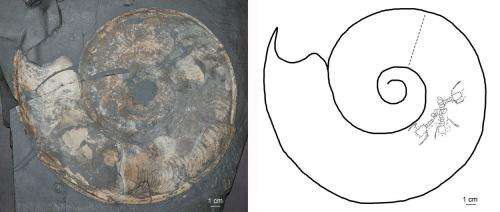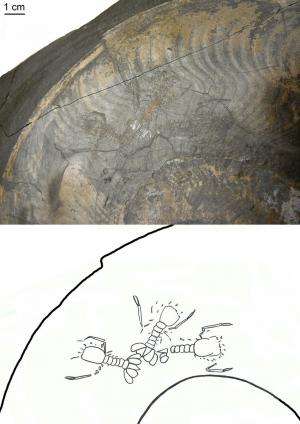World record find: Oldest evidence of lobsters living together discovered in gas shale

(PhysOrg.com) -- Discovering direct animal behavior from the fossil record can only be done in exceptional circumstances. Such circumstances exist in the German Posidonia gas shale from the Jurassic period in which organic material from fossils is preserved. A treasure trove of fossils found in the Dotternhausen quarry south of Stuttgart, Germany, has now yielded a world record for fossil lobsters living together, according to Kent State University researcher Adiël Klompmaker.
The news was published on March 7 in the multidisciplinary journal PLoS ONE.
“This is also a world record for decapods, a group that includes crabs and shrimp as well as lobsters,” explains lead author Klompmaker, a Ph.D. candidate in the Department of Geology at Kent State University. “These 180 million-year-old lobsters from the Eryonidae family are millions of years older than the previous record for lobsters from Greenland, and about 100 million years older than the record for shrimp. Thus, this type of behavior for decapods developed earlier in earth’s history than previously known.”
“The lobsters were discovered in a flattened shell of an extinct squid-like animal, the ammonite Harpoceras falciferum,” said co-author Dr. René Fraaije, director of the Dutch Oertijdmuseum. “This ammonite died, upon which the shell sank to the sea floor and became available for the lobsters.”

“The exceptional mode of preservation allowed us to look through the only preserved part of the ammonite shell, the periostracum,” Klompmaker said. “This organic material is very thin and translucent, which is why we could discover the three lobsters under low angle light.”
The well-preserved corpses of lobsters were oriented in a circle with the tails toward each other. Why exactly the lobsters were gathered inside the ammonite remains mysterious. “They may have sought a temporary shelter against predators, such as fish, or used it as a long-term residency,” Klompmaker said.
The lobsters were found in the same German shale in which the sea reptiles Ichthyosaurus and Plesiosaurus were discovered. These types of shales may contain significant amounts of natural gas, which is why they can be important economically. Shales containing natural gas are found also in the subsurface of Ohio and Pennsylvania.
Fraaije and Klompmaker were recently involved in the discovery of a new hermit crab named after the late singer Michael Jackson because it was found on the date the superstar passed away. Earlier, Kent State researchers studied and reported on the oldest known fossil shrimp, extraordinarily preserved with muscles.
More information: The article can be found at dx.plos.org/10.1371/journal.pone.0031893.
Provided by Kent State University


















